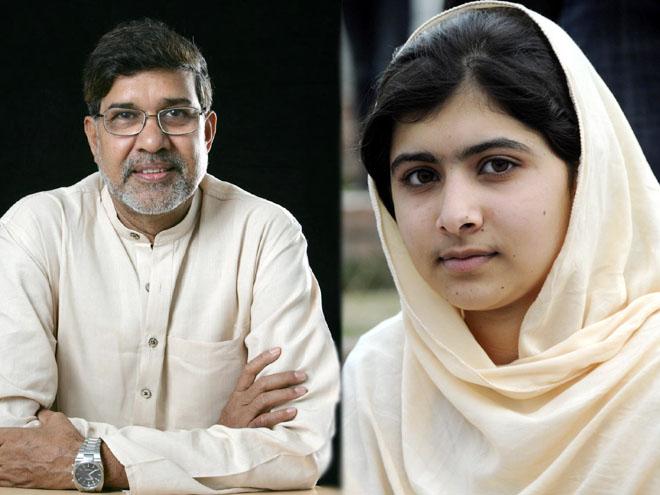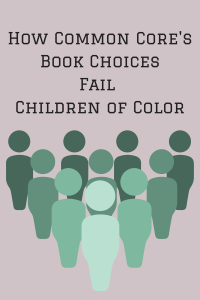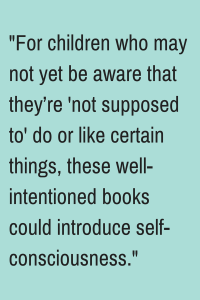It finally feels like autumn is here and if you don’t mind us saying, we’ve been “fall-ing” for all the diversity-related stories that have been in the news recently! Here are a few that we were especially excited to read: Malala Yousafzai, the Pakistani teen who was shot in the head by the Taliban for advocating for girls’ rights to education, and Indian children’s right activist Kailash Satyarthi, both won the 2014 Nobel Peace Prize for their fight against the oppression of children and young people, and for the right of all children to education. In light of the recent violence that has broken out between India and Pakistan along the border of the disputed, mainly Muslim region of Kashmir, the Nobel Peace Prize committee said it was an “important point for a Hindu and a Muslim, an Indian and a Pakistani, to join in a common struggle for education and against extremism.”
Malala Yousafzai, the Pakistani teen who was shot in the head by the Taliban for advocating for girls’ rights to education, and Indian children’s right activist Kailash Satyarthi, both won the 2014 Nobel Peace Prize for their fight against the oppression of children and young people, and for the right of all children to education. In light of the recent violence that has broken out between India and Pakistan along the border of the disputed, mainly Muslim region of Kashmir, the Nobel Peace Prize committee said it was an “important point for a Hindu and a Muslim, an Indian and a Pakistani, to join in a common struggle for education and against extremism.”
An Interview with Lin Oliver on SCBWI’S Emerging Voices Award
On this blog we’ve often discussed our own New Voices and New Visions awards for unpublished authors of color. Today we wanted to spotlight another great award specifically for authors of color: the On-The-Verge Emerging Voices Award from the Society of Children’s Book Writers and Illustrators (SCBWI).

The On-The-Verge Emerging Voices Award is a grant created to “foster the emergence of diverse voices in children’s books.” It offers two writers or writer/illustrators from under-represented backgrounds the chance to receive:
- An all-expense paid trip to the SCBWI Summer Conference in Los Angeles August 1-4, 2015 (transportation and hotel)
- Tuition to the SCBWI Summer Conference
- A manuscript consultation at the Summer Conference with an industry professional
- An additional meeting with an industry professional
- Tuition to the Summer Conference Writers or Illustrators Intensive
- A press release
We interviewed Lin Oliver, Executive Director of SCBWI, about the creation of the award and the role of SCBWI in diversifying the world of children’s book publishing.
How Common Core’s book choices fail children of color
The Common Core has become a hot-button political issue, but one aspect that’s gone lar![]() gely under the radar is the impact the curriculum will have on students of color, who now make up close to 50% of the student population in the U.S. In this essay, Jane M. Gangi, an associate professor in the Division of Education at Mount Saint Mary College and Nancy Benfer, who teaches literacy and literature at Mount Saint Mary College and is also a fourth-grade teacher, discuss the Common Core’s book choices, why they fall short when it comes to children of color, and how to do better. Originally posted at The Washington Post, this article was reposted with the permission of Jane M. Gangi.
gely under the radar is the impact the curriculum will have on students of color, who now make up close to 50% of the student population in the U.S. In this essay, Jane M. Gangi, an associate professor in the Division of Education at Mount Saint Mary College and Nancy Benfer, who teaches literacy and literature at Mount Saint Mary College and is also a fourth-grade teacher, discuss the Common Core’s book choices, why they fall short when it comes to children of color, and how to do better. Originally posted at The Washington Post, this article was reposted with the permission of Jane M. Gangi.
Children of color and the poor make up more than half the children in the United States. According to the latest census, 16.4 million children (22 percent) live in poverty, and close to 50 percent of country’s children combined are of African American, Hispanic, American Indian, Asian American heritage. When the Common Core State Standards (CCSS) were introduced in 2009—2010 , the literacy needs of half the children in the United States were neglected. Of 171 texts recommended for elementary children in Appendix B of the CCSS, there are only 18 by authors of color, and few books reflect the lives of children of color and the poor.
When the CCSS were open for public comment in 2010, I (Gangi) made that criticism on the CCSS website. My concerns went unacknowledged. In 2012, I presented at a summit on the literacy needs of African American males, Building a Bridge to Literacy for African American Male Youth, held at the University of North Carolina in Chapel Hill. Emily Chiarello from Teaching Tolerance acknowledged the problem and connected me with Student Achievement Partnership, an organization founded by David Coleman and Sue Pimental, “architects” of the English Language Arts standards.
Poetry Friday: Hair
Happy Friday everyone! We’ve chosen a poem from Lend a Hand: Poems About Giving to kick off the weekend:
Hair
It took six years
to grow my hair this long.
A few quick snips
Your Legend of Korra recap post
The Legend of Korra’s fourth and final season, Book 4: Balance, returns this Friday! You’ll be able to watch here. Trying to catch up with all three seasons in one day is a pretty tall order, but luckily the weekend will soon be here! The first three books (as seasons are called Avatar: The Last Airbender and Legend of Korra) are available streaming on Nick.com.
Avatar: the Last Airbender follows Aang, the last airbender, who survived the Air Nomad genocide from the Fire Nation. Together with his friends Sokka, Katara and Zuko, Aang fights to prevent the Fire Nation from taking over the whole world, all the while mastering all four elements.
The Legend of Korra is the direct sequel to Avatar: the Last Airbender, taking place 80 years after the end of ALTA. Korra, upon discovering she was the avatar at the age of four, was placed under the direct care of the Order of the White Lotus and learned to water-, fire-, and earthbending. Korra sneaks away from the Order of the White Lotus compound to learn airbending from Tenzin, the son of Avatar Aang, in Republic City.
Important Terms
Elements: Air, Water, Earth, and Fire.
Bending: The ability to control one of the aforementioned elements, i.e. waterbending. A person who bends an element is known as a bender.
Avatar: one person who has the ability to control all four elements. The avatar is born into one of the four nations and learns to bend the four elements. The Avatar is supposed to help maintain balance between the Four Nations and the spirits.
Gender Matters? Swedish Picture Books and Gender Ambiguity
![]() Back in June, Laura Reiko Simeon wrote about how race is handled in Swedish picture books. We’re thrilled to host Laura again as she sheds light on how Swedish picture books handle gender and gender-ambiguous characters.
Back in June, Laura Reiko Simeon wrote about how race is handled in Swedish picture books. We’re thrilled to host Laura again as she sheds light on how Swedish picture books handle gender and gender-ambiguous characters.
You sit down with your favorite 4-year-old to read a sweet, wordless picture book featuring a little duck swimming down the river. Quickly, without thinking too hard, what pronoun do you use to describe the duck? Do you say, “Look at him paddle past that shaggy dog!” or “What does she see in the sky?”
If you were like the mothers in a 1985 study, you would use masculine pronouns for 95% of animal characters with no gender-specific characteristics. A follow-up study from 1995 examined children’s use of pronouns and found that by age 7 they had absorbed and were repeating these same gender stereotypes. Listen to those around you: has it changed much since then?
In the US, Sweden is widely regarded as a leader in gender equality, although many Swedes still see a need for greater progress. Meanwhile, our own biases are apparent, for example when we consider gendered toys. Compare this 1981 Lego ad, with its blue jeans and t-shirt-clad girl to the pink-infused products targeted at girls today. As with other social issues, picture books reflect concerns in society at large – but how they’ve done so is dramatically different in the US as compared to Sweden.
Book Activities for the Family
 Amanda Boyarshinov is one of the creators of the blog, The Educators’ Spin On It, a site that makes everyday moments into teachable opportunities. She has a Master of Reading Education for grades K-12 and a B.A. in Elementary Education. Additionally, she has her English Speakers of Other Languages (E.S.O.L.) endorsement and has received her National Board Certification in Early Childhood Education. In this post, we’ve been given permission to share her steps on building a family theme Love Book Basket, as well as how to create an “I Love You” book.
Amanda Boyarshinov is one of the creators of the blog, The Educators’ Spin On It, a site that makes everyday moments into teachable opportunities. She has a Master of Reading Education for grades K-12 and a B.A. in Elementary Education. Additionally, she has her English Speakers of Other Languages (E.S.O.L.) endorsement and has received her National Board Certification in Early Childhood Education. In this post, we’ve been given permission to share her steps on building a family theme Love Book Basket, as well as how to create an “I Love You” book.
HOW TO BUILD A FAMILY THEME LOVE BOOK BASKET
1. Choose a Book
Select themed literature that is appropriate for your child’s age. Younger children may enjoy shorter stories. Older children may like more detailed picture books. Consider both non-fiction and fiction text. Lee and Low Publishing Company sent me the 3 books to read with my children for this article. All thoughts and opinions are 100% my own.
New Visions Award Reminder
 We’ve been excited to receive so many great manuscripts for our second annual New Visions Award! We just wanted to give you a reminder that the contest ends October 31, 2014, so get those manuscripts in! The New Visions Award, which was created in 2012, will be given to a middle grade or young adult fantasy, science fiction, or mystery novel by a writer of color. Established by Tu Books, an imprint of LEE & LOW that publishes YA and middle grade science fiction and fantasy, the award is a fantastic chance for new authors of color to break into the world of publishing for young readers.
We’ve been excited to receive so many great manuscripts for our second annual New Visions Award! We just wanted to give you a reminder that the contest ends October 31, 2014, so get those manuscripts in! The New Visions Award, which was created in 2012, will be given to a middle grade or young adult fantasy, science fiction, or mystery novel by a writer of color. Established by Tu Books, an imprint of LEE & LOW that publishes YA and middle grade science fiction and fantasy, the award is a fantastic chance for new authors of color to break into the world of publishing for young readers.
Cover Reveal: Rose Eagle
Last fall, Tu Books released Killer of Enemies, a post-apocalyptic steampunk adventure by Joseph Bruchac. Readers were introduced to seventeen-year-old Apache hunter Lozen, a kick-butt warrior who kills monsters to ensure the safety of her family.
Set to be released next month, Joseph Bruchac has written an e-novella that’s a prequel to Killer of Enemies, titled Rose Eagle.
Rose Eagle is set in the Black Hills of South Dakota, where readers are introduced to seventeen-year-old Rose Eagle of the Lakota tribe who is trying to find her place in a post-apocalyptic world.
How We Feel About Amazon
 In this post, Publisher Jason Low shares his feelings on the Amazon vs. Hachette battle, the future of publishing, and the view from here as a small publisher.
In this post, Publisher Jason Low shares his feelings on the Amazon vs. Hachette battle, the future of publishing, and the view from here as a small publisher.
Since the great Amazon-Hachette feud of 2014 started this summer, many people have asked where we stand. It is no secret that we do business with Amazon—almost every publisher does. At the same time, what I see from Amazon, and where I see the book industry heading as a result, worries me.
To me, Amazon is a different animal. It is unlike any other corporation out there because of the way it treats the bottom line. The problem is, Amazon’s bottom line is growth, not profits. In sacrificing profits they have made a conscious decision to sell books at unsustainable prices, undercutting any and all competitors who are still operating under the profit model, which is everyone.
The consequences of this are twofold. First, it puts other companies out of business, straight and simple. We have seen the continual decrease in the number of independent and even chain bookstores over the last several years as Amazon increases its market share.



